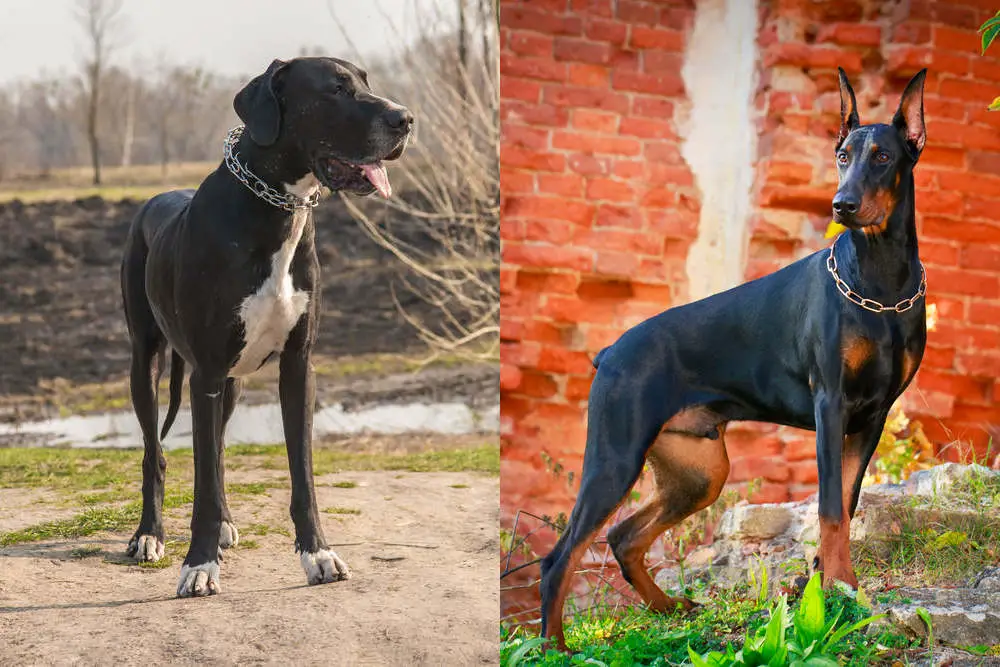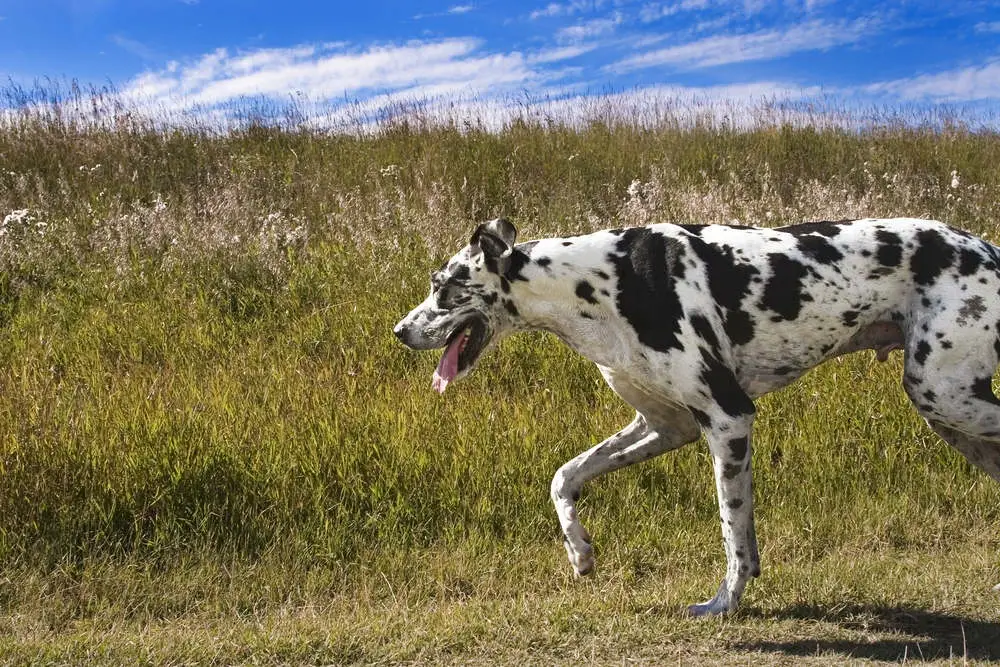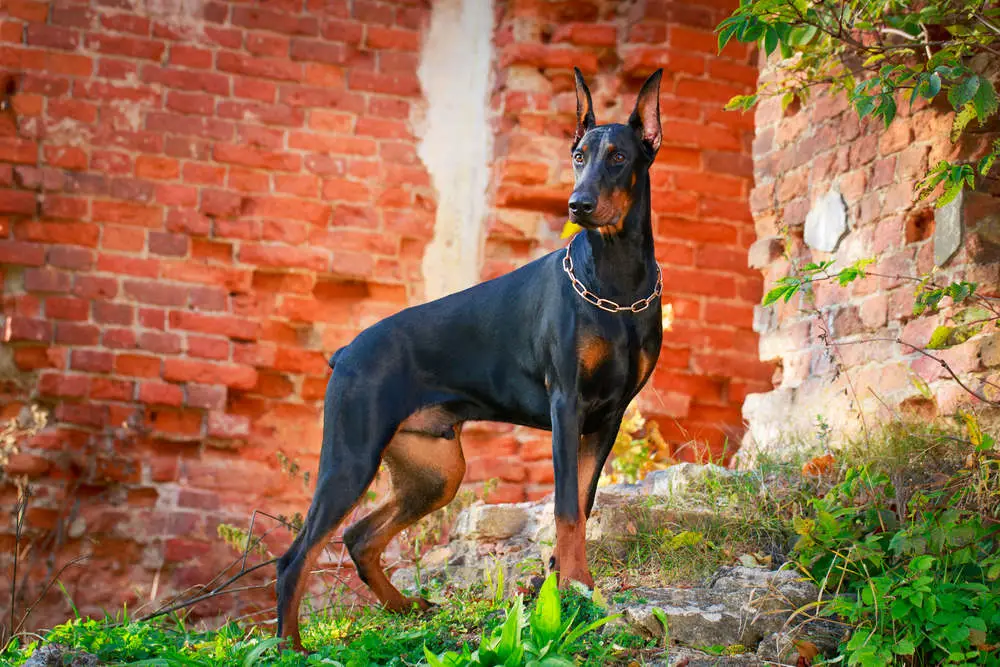
Great Danes and Dobermans (or the Dobermann or Doberman Pinscher) are two majestic dog breeds that are popularly kept as pets. If you are confused between the two or simply want to know more about how they are similar and how they differ, you can go through the following points that make them unique.
These will help you make your decision about which dog to opt for.
Origins
Great Danes have their origins in Germany. In the 16th century, these dogs were found to descend from hunting dogs and then started to be bred in the following century for keeping in the German noble courts.
The royalty mainly kept these dogs and also took them along for hunting animals like deer, bears and boars. They are now largely kept as pets or as guard dogs.
Dobermans also have their origins in Germany, although they came about as a breed much later than the Great Danes. They were bred in 1890 by a tax collector named Louis Dobermann to accompany him on his job for protection, following which the dogs began to be bred for hunting, war and for keeping watch.
Size
Both Great Danes and Dobermans are large-sized dogs. Great Danes, however, tend to be slightly bigger and more muscular than Dobermans.
Great Danes tend to measure around 30 inches in height, with some males going up to 35 inches as well. They typically weigh anywhere between 110 and 180 pounds, with males weighing more than females.
Dobermans tend to measure around 25-28 inches in height while weighing anywhere between 60 and 100 pounds.
You should note that these sizes are not absolute. There can be a few differences depending on a particular dog’s genes and lifestyle, although the general range usually remains more or less similar.
Lifespan
There tends to be a bit of a difference between the lifespan of a Great Dane and that of a Doberman.
For instance, Great Danes usually live up to 10 years, although the range is usually around 7-10 years. On the other hand, Dobermans have a slightly longer lifespan which measures around 10-12 years.
It is difficult to explain why this difference in lifespans is so pronounced, although it might have to do with the genetic and breeding elements in addition to a quicker metabolism while they are still young.
Additionally, there are some other factors such as health issues, poor lifestyle and environment and stress that can shorten the lifespan of these dogs.
Coat
Great Danes and Dobermans both tend to have extremely short coats, lending them a neat, clean and sleek appearance. Their coats are also extremely smooth yet thick, keeping them well protected in warm as well as cold months.
As a result of such short coats, both breeds are very easy to clean and maintain. However, they do tend to shed their hair a bit, with Dobermans shedding a lot more as compared to Great Danes.
This is an important thing to note so that you know what to expect when it comes to cleaning up around the house and determining the distance between your dog and important belongings and furniture in the house.
Colors

The breed standard for Great Danes mainly tends to include the following acceptable colors:
- Black
- Black and white
- Fawn
- Brindle
- Harlequin (white with black patches or spots)
- Mantle
- Blue
- Grey merle
- Silver
- White
Some acceptable markings include white and black and a black mask.
For Dobermans, the breed standard prescribes the following colors, each of which can emerge from the black and color dilution genes that they possess.
- Black and rust
- Fawn
- Blue and rust
- Red and rust
White is an unacceptable color for Dobermans since it results in health issues such as deafness and blindness. This is also the case with the Great Danes even though white is sometimes acceptable.
Grooming Requirements
An important grooming requirement for Great Danes and Dobermans is managing the hair that they shed, particularly during the months of spring. Make sure you brush their coats almost daily in these months while reducing the frequency to a couple of times per week in other months.
There are several other grooming requirements that you will need to take care of for these dogs. For Great Danes, for instance, you should bathe them once every two months or so with suitable shampoo and conditioner, although you might need to wash them (just with water) more often.
Dobermans also require bathing once every two months.
For both dogs, other kinds of grooming include cleaning and cutting nails, brushing teeth and cleaning the ears. Make sure you carry these out with caution or simply take your dog to a grooming service.
Temperament
A marked difference between the two dog breeds can be their temperament.
Great Danes are highly affectionate dogs. They tend to be quite playful and flexible and are able to adapt themselves to new situations and contexts fairly quickly.
They are also quite gentle and reliable dogs while also being loyal and calm. They are not usually aggressive unless they do not have enough training and socialization.
Dobermans are also extremely friendly, loving and affable. They love being around their owners and playing around with them. These dogs are quite loyal and adaptable as well. They are also quite fearless and watchful, with most of them lacking aggression unless they are with strangers or lack training and socialization.
Energy Levels
Both Great Danes and Dobermans have incredibly high levels of energy, with Dobermans having just a little more energy than Great Danes. Considering that these dogs are large, lean and muscular, these dogs need plenty of ways in which they can release some of their energy.
Their big size in addition to their breeding origins as hunting and guarding dogs can make them pretty energetic.
You should keep these energy levels in mind before you decide to get either of these dogs, especially considering the fact that they will both become restless, bored and quite possibly aggressive and destructive if they constantly have some pent-up energy without any kind of outlet.
Stimulation Requirements

Given that Great Danes and Dobermans have high levels of energy, both these breeds need plenty of physical as well as mental stimulation. It is important for you to provide them with around two hours of exercise on a daily basis to help them release their energy while also keeping them healthy and happy.
This exercise can include long walks, running, swimming, playing games (such as fetch) outdoors or any other kind of activity that you might think of. Do not, however, overwork them and avoid such intense exercise if they are still puppies.
Mental stimulation is another essential part of this. Keep giving them toys and puzzles that they can solve on their own as this will help keep them sharp and occupied, without which they might become bored and restless.
Both kinds of stimulation can help tire them out without any chances of acting out.
Drooling
How much do Great Danes and Dobermans drool? Does it matter?
Great Danes actually tend to drool quite a bit. One can attribute this to their square face shape, folds of skin on their face as well as loose lips.
This combination makes it difficult for them to hold in the saliva, which then ends up drooling out of the mouth. This will also require you to clean up often after Great Danes, often several times a day.
In comparison, Dobermans are quite clean considering that they drool pretty minimally. Yet, there are still some occasions that might cause them to drool, so it can always help to keep a towel around.
Barking
In terms of barking, both Great Danes and Dobermans are moderately vocal. When they do bark, they usually do it to alert their owners of a particular threat or if they want to communicate a certain need to them.
Sometimes, they might simply do it because they are excited and want to play around. They may also bark at strangers often, especially if they view them as a threat or if they are fearful of someone they come across.
This kind of moderate barking in both breeds is quite normal, although you should track the frequency and source. If it comes from an unhealthy or fearful cause or if it happens too often, you might need to provide some training to reduce it.
Care
It is essential for you to care for these dog breeds. While both of these breeds can be fairly independent, they still require plenty of attention, love and care.
Make sure you do not leave them alone for too long and make it a point to feed them well several times a day. Keep them hydrated, clean them up when they are dirty, keep them occupied and make sure they are warm when it is cold.
There might be some dog-specific care that you will need to provide as well.
Trainability
Great Danes can sometimes be a bit stubborn, which might present a few difficulties in terms of training them. However, they are still quite loyal and obedient if they live in a healthy environment and can learn to do well if you rely on positive reinforcement instead of punishment.
Dobermans, on the other hand, are highly trainable and extremely eager to please due to the level of affection and obedience that they tend to have. You are unlikely to face too much difficulty training them as long as you steer clear of aversive methods of training.
For both breeds, it can be much more effective if you start at a young age.
Health
Some common health issues that Great Danes are likely to face include:
- Bloating (due to quick metabolism) or gastric dilatation-volvulus
- Hip dysplasia
- Congenital heart diseases
- Wobbler disease (affecting the vertebrae due to quick growth rate)
Health issues that are pretty common to Dobermans include the following:
- Dilated cardiomyopathy (leading to an enlarged heart)
- Wobbler disease
- Prostate issues
- Bleeding disorder
- Compulsive disorder
Make sure you keep track of any unusual symptoms or behavior in your dogs and get the condition diagnosed and treated on time.
Vigilance
Great Danes and Dobermans are both highly vigilant, watchful, alert and protective dogs. This stems from the fact that they were bred and used for hunting, as war dogs and as guard dogs.
This can help ensure that they will guard your house even if you are not at home, although they might require a bit of training to get them to obey and react as you want them to.
Even professionally, these dogs still continue to be used for guarding.
Intelligence
While Great Danes can exhibit a great deal of intelligence and sharpness, the Doberman is much more intelligent in comparison.
This kind of intelligence can refer to problem-solving, quick responses, communication, learning and retention. In fact, according to a ranking in the book, The Intelligence of Dogs by Stanley Coren, Dobermans are the fifth in the list in terms of training.
Sociability
Sociability can refer to how dogs react in the company of other people and animals.
Great Danes are sociable with people they are familiar with, although they might take a bit of time to become sociable with kids and other pets in the household. They are also a bit cautious when it comes to strangers.
On the other hand, a Doberman is highly affectionate not only with the family but also with infants and kids in the house. They are also more open to strangers than Great Danes, although they might take some time warming up to other pets.
It is important to provide sufficient socialization to both breeds from a young age.
Summing Up
It is clear that the Great Dane differs from the Doberman on the basis of various factors and criteria, such as their history, size, coat lengths and colors, temperament, stimulation needs, care, intelligence, sociability and several others.
Now that you know these differences, you can decide which dog would suit you and your family more so that you can finally bring them home.
